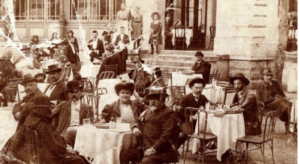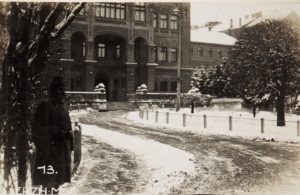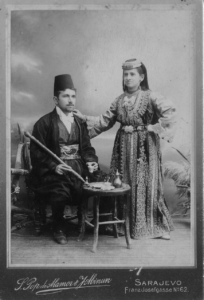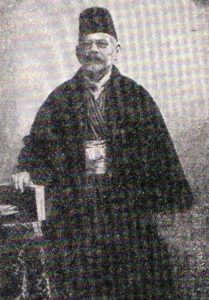
A Sarajevo Purim
In 1817 an incident occurred in Travnik which would change the schedule of religious holidays for Sarajevo’s Jews forever. It did seem like a big deal at the time, although it wasn’t too different from the sorts societal stresses which happen from time-to-time when multiple religions have to coexist in one space. It certainly did not seem like something that would change the religious celebration calendar.
A man in Travnik named Moses Chavijo converted to Islam, took the name Derviš Ahmed and began to defame and attempt to incite Muslim violence against the Jewish community. The Jews of Travnik complained about the attacks and eventually Ahmed was executed for the attacks.
Two years later, in 1819, Mehmed Ruzdi Pasha, the governor in Bosnia, found a way to use this incident to his advantage. Claiming that the Jewish community was responsible for Ahmed’s death he arrested the Chief Rabbi of Sarajevo, Moshe Danon, and ten prominent local Jews. Mehmed Pasha pronounced a sentence – that either the Jewish community must come up with the impossible sum of 500,000 groschen or all the Jews in custody would be put to death.
The amount could not be raised, so on the Shabbat before the execution was scheduled a prominent member of the Jewish community, Rafael Ha-Levi – known everywhere in Sarajevo for his piety, went from coffeehouse to coffeehouse. At this time in history Jews were banned from coffeehouses within the Ottoman Empire, so it was not an activity to be taken lightly in any way. Not only was Ha-Levi’s violation of his Shabbat shocking, but his entrance into these hallowed places of čejf (all day coffee drinking, smoking, and debate) was guaranteed to command attention.

Ha-Levi entered each coffeehouse, ordered coffee, paid for it with a gold coin, then told the story of Rabbi Moshe Danon and the ten imprisoned Jews in each coffeehouse. He then drank his coffee and left.
The local Muslims were enraged. As a body they headed to the house of Ahmed Barjakter Bjelavski – the commander of the Bjelavi neighborhood. As the commander of a neighborhood where Jews and Muslims lived together, the Barjakter took charge and yelled out, “By Allah, I will not allow this injustice!” and summoned all the Barjakters in Sarajevo.
Together with the locals from the coffeehouses, the leading Muslims of Sarajevo stormed Kanak – the governor’s residence. They freed the prisoners, and although many tellings of the story claim that Mehmed Ruzi Pasha fled before them in terror, the Muslim residents of Sarajevo actually held him in the barracks for five days until he agreed to sign a document stating the goodness of all in Sarajevo and that he had no problems with anyone while he was there.

But the Muslim community did not stop there in their efforts to protect their Jewish community city brethren. They then penned a letter to the Sultan himself, complaining about the evils of the Pasha. This letter was signed by the 249 most prominent Muslims in Sarajevo, and it resulted in the removal of the man who had tried to murder Sarajevo’s Jews.
There is a legend that after his rescue, Rabbi Moshe Danon led the crowd that freed him to the synagogue, where he read the story of Purim. Whether it was true or not, the tradition has carried on, and the Sarajevo Purim is celebrated every year in November.
But that is not how this Balkan tale ends.

For ten years after his rescue, Rabbi Moshe Danon led a prayerful and grateful life, with the intention of traveling to and dying in Palestine. Finally, all was ready and he set off with a group of attendants and travelers.
Unfortunately, the good Rabbi did not make it. He stopped in the Herzegovinian city of Stolac, where he died and was buried under a large tomb.
But again, that is not where this Balkan tale ends.
Another prominent Sarajevo Jew, Mose Rafael Attias (also known as Zeki Effendi due to his extensive studies of Islam) felt the need to write about this incident – even, at one point, claiming that Rabbi Moshe Danon had come to him in a dream. The book that was the result, The Sarajevo Megillah, was written in Ladino and tells the story behind the celebration of the Purim di Saraj. It also describes the pilgrimage to the grave of Rabbi Moshe Danon, which occurs in June of each year.

The grave of the Rabbi is visited by people of many faiths. Although there are special Ladino songs and a particular prayer for the visit, non-Jewish visitors also make their way to the tomb to pray for special guidance. Near the tomb is a blackberry bush that is said to have healing powers for people of any faith who eat the berries.
But again, that is not how this Balkan tale ends.
Because nearly two hundred years after his death, Rabbi Moshe Danon is still uniting people of all faiths in Bosnia and Herzegovina.
- June 7, 2020
- Bosnia and Herzegovina
